|

Home
Mission
Overview of Project
Project Staff
Sponsors
Achievements
Checking, Illustrations
Upcoming Activities
Id and Species Lists
Protea Information
Protea Gallery
Growing Proteas
Interim Dist. Maps
Publications
Afrikaanse Inligting
SANBI
|
|

Bearded Sugarbushes - Proteas
| Green Sugarbush -
Protea coronata |
|
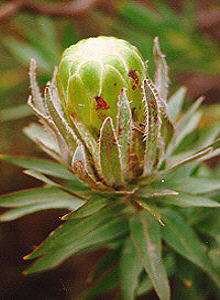 |
Habit: Erect shrub 2 to 3m
tall
Fire survival: Killed, only seeds survive
Sexual system: Both sexes in each flower
Flowers: April - September, peaking May and June
Pollinator: Birds
Fruit: Stored on plant
Seed dispersal: Wind
Seed storage: In seedheads on plant
Rarity status: Not threatened, locally common
Habitat: Heavy clay soils with high rainfall, 200-750m
Distribution: Cape Peninsula, Du Toits Kloof to Koegelberg,
Riviersonderend, Bredasdorp Mountains, Potberg, Langeberg and Outeniqua Mountains |
| Red Sugarbush - Protea
grandiceps |
|
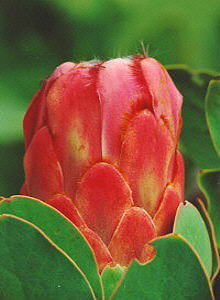 |
Habit: Rounded shrub up to
2m tall
Fire survival: Killed, only seeds survive
Sexual system: Both sexes in each flower
Flowers: September - January
Pollinator: Bird
Fruit: In seedheads on plant
Seed dispersal: Wind
Seed storage: In seedheads on plant
Rarity status: Known from a dozen isolated sites
Habitat: Dry uppermost slopes, 1200-1700m
Distribution: Cape Penisula, Hottentots-Holland - Riviersonderend
Mountains, Langeberg, Outeniqua, Winterhoek and Kammanasie Mountains |
| Sawedge Sugarbush
- Protea holosericea |
|
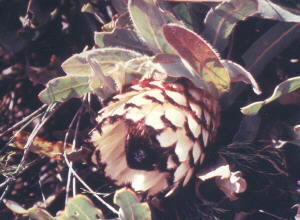 |
Habit: An almost erect
shrub up to 1.2m tall
Fire survival: Killed, only seeds survive
Sexual system: Both sexes in each flower
Flowers: September - October
Pollinator: Birds
Fruit: Stored on plant
Seed dispersal: Wind
Seed storage: In seedheads on plant
Rarity status: Rare, almost picked to extinction in 1970s
Habitat: Arid rocky slopes, 1200-1300m
Distribution: Keeromsberg at Sawedge Peak |
| Grey-leaf
Sugarbush - Protea laurifolia |
|
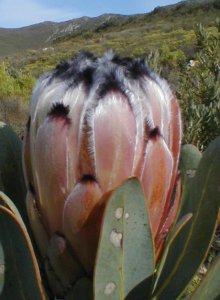 |
Habit: Tall erect shrub to
8m tall
Fire survival: Usually killed, only seeds survive
Sexual system: Both sexes in each flower
Flowers: April - November
Pollinator: Bird
Fruit: Stored on plant
Seed dispersal: Wind
Seed storage: In seedheads on plant
Rarity status: Not threatened
Habitat: Sandy or granite soils, 400-1200m
Distribution: Nieuwoudtville to Franschhoek and Anysberg |
| Black-beard
Sugarbush - Protea lepicarpodendron |
|
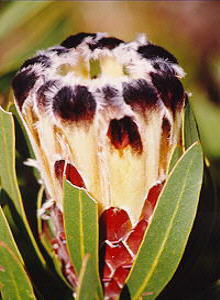 |
Habit:
Erect shrub to 3m tall
Fire survival: Killed, only seeds survive
Sexual system: Both sexes in each flower
Flowers: April - August
Pollinator: Bird
Fruit: Stored on plant
Seed dispersal: Wind
Seed storage: In seedheads on plant
Rarity status: Not threatened
Habitat: Sandy soils, ferricrete and granite, 0-600m
Distribution: Peninsula to Bredasdorp
Note: Easily confused with Narrowleaf Sugarbush, but has two-toned bracts
and black hairs below beard |
| Strap-leaf
Sugarbush - Protea lorifolia |
|
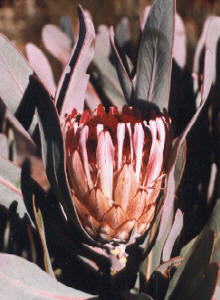 |
Habit: Compact rounded
shrub up to 3m tall
Fire survival: Killed, only seeds survive
Sexual system: Both sexes in each flower
Flowers: April - October
Pollinator: Bird
Fruit: In seedheads on plant
Seed dispersal: Wind
Seed storage: In seedheads on plant
Rarity status: Not threatened
Habitat: Dry slopes, sandstone soils, 450-1400m
Distribution: Koue Bokkeveld to Swartberg, Riviersonderend Mountains,
Langeberg to Kouga, Baviaanskloof Mountains, Grahamstown, Riebeek East and Bosberg at
Somerset East |
| Queen Sugarbush -
Protea magnifica |
|
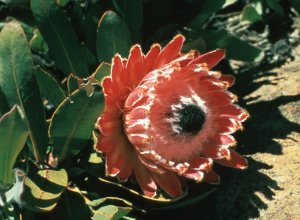 |
Habit: An erect to
sprawling shrub up to 2.5m tall
Fire survival: Killed, only seeds survive
Sexual system: Both sexes in each flower
Flowers: June - January
Pollinator: Bird
Fruit: In seedheads on plant
Seed dispersal: Wind
Seed storage: In seedheads on plant
Rarity status: Not threatened, locally common in isolated stands
Habitat: Montane, hot dry slopes near the snow line, 1200-2700m
Distribution: Koue Bokkeveld to Hottentots-Holland Mountains, Klein
Swartberg, Riversonderend Mountains and central Langeberg
Notes: Heavily picked - the prize cut flower in the trade. The best
flowerheads still come from the wild |
| Narrow-leaf
Sugarbush - Protea neriifolia |
|
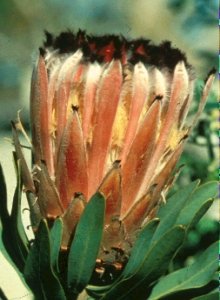 |
Habit: An erect shrub up
to 3m tall
Fire survival: Killed, only seeds survive
Sexual system: Both sexes in each flower
Flowers: February - November
Pollinator: Bird
Fruit: Stored on plant
Seed dispersal: Wind
Seed storage: In seedheads on plant
Rarity status: Not threatened
Habitat: Sandstone, occasionally granite soils, 0-1300m
Distribution: Hottentots-Holland Mountains to Riviersonderend Mountains
and Langeberg to Winterhoek Mountains and Elandsberg, Rooiberg, Kammanasie Mountains,
Potberg, Tulbagh and Ceres
|
| Brown-beard
Sugarbush - Protea speciosa |
|
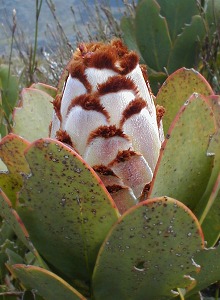 |
Habit: A low shrub 0.5 to
1.2m tall with rootstock
Fire survival: Resprouts from underground bole
Sexual system: Both sexes in each flower
Flowers: June - January, peaking September - October
Pollinator: Bird
Fruit: Stored on plant
Seed dispersal: Wind
Seed storage: In seedheads on plant
Rarity status: Not threatened
Habitat: Montane, cool, southern slopes, 0-1300m
Distribution: Cape Peninsula to Bredasdorp Mountain
|
| Pink Sugarbush - Protea
stokoei |
|
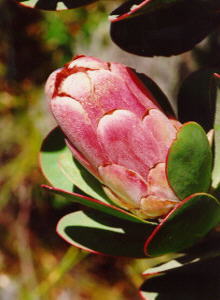 |
Habit: Tall shrub to 3m
tall
Fire survival: Killed, only seeds survive
Sexual system: Both sexes in each flower
Flowers: May - October
Pollinator: Bird
Fruit: Stored on plant
Seed dispersal: Wind
Seed storage: In seedheads on plant
Rarity status: Not threatened, rare
Habitat: Moist peaty soils, 900-1200m
Distribution: Kogelberg to Groenland mountains around Elgin |
Back Sugarbush Gallery
|

![]()









